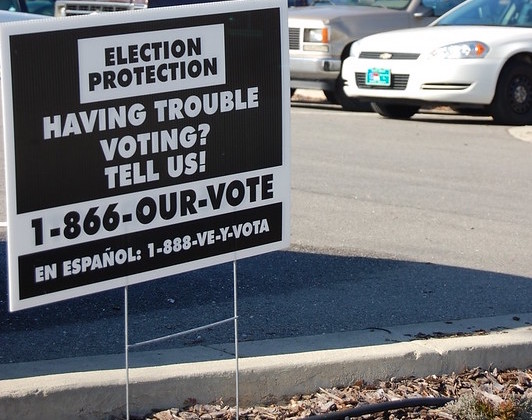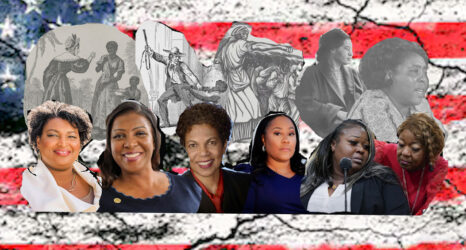
“I am urging my supporters to go into the polls and watch very carefully, because that’s what has to happen,” said Trump during the first presidential debate in September—prompting immediate concerns.
While certified poll watchers have legally observed voting procedures in past elections, many fear Trump’s comments may encourage illegal intimidation tactics among his supporters, hoping to scare off Democratic voters and people of color.
Voter intimidation, classified by federal law as “attempts to intimidate, threaten or coerce, any other person for the purpose of interfering with the right of such other person to vote or to vote as [s]he may choose,” is illegal in all instances—but has a particularly complicated history within the Republican party.
In the 1981 New Jersey state elections, hundreds of local armed, off-duty police officers and sheriffs descended upon largely Black and Hispanic polling locations in Trenton. The vigilantes, dressed in official-looking armbands, called themselves the “National Ballot Security Task Force” and spent Election Day intimidating voters—demanding voter registration cards from voters waiting in line, turning others away and intimidating some into not voting at all.
A court complaint later lodged by the Democratic Party described the members of the task force “harassing poll workers, stopping and questioning prospective voters … and forcibly restraining poll workers from assisting, as permitted by state law, voters to cast their ballots.”
While this sounds like a nightmare for democracy, the group was not some rogue citizen militia. Who sent them? None other than the Republican National Committee.
In response, the following year, a lawsuit resulted in a court order that prevented the RNC from organizing poll watching efforts, and required Republicans to obtain court approval for their use of poll monitors, since they had used “poll watching” as a cover for voter suppression.
However, these restrictions were lifted by a federal judge in 2017, during Trump’s presidency—a big victory for Republicans set on voter intimidation.
“If we were not in the Trump administration, I wouldn’t expect very much to change. The RNC has been very careful to instruct people associated with it not to engage in any activities that might be seen as suppressing the vote,” Professor Rick Hasen of University of California, Irvine told NPR prior to the 2018 midterm elections. “But Trump adds something different here. He has made voter fraud a centerpiece of his rhetoric about campaigns.”
In May, before Trump had announced his election qualms on the debate stage, the RNC had already begun recruiting up to 50,000 volunteers to patrol polling locations.
“They don’t need to keep millions of people away” said Fair Fight senior advisor Lauren Groh-Wargo. “Challenge a couple of voters here, a couple there, and it all aggregates up. They realize they’re going to win or lose this thing at the margins.”
People of color, who face the largest threat based on their presumed political alignment and history of harassment and intimidation, aren’t standing idly by in the face of potential suppression. Latinx advocacy group, Mi Familia Vota Education Fund, is going so far as to sue the Trump administration over claims of election sabotage.
Many fear that even if observers don’t succeed in driving voters away from polling locations, they could prevent people of color from showing up in the first place. Additionally, Trump’s rhetoric surrounding mail-in voting could depress other forms of participation.
In addition, the ACLU’s definition of voter intimidation includes harassment over citizenship status or criminal records—of which Americans of color are the likeliest targets. It is also illegal to claim that voters are required to speak or vote in English, which they are not.
“We want to make sure that Trump stops with misinformation,” said Mi Familia Vota’s state director, Eduardo Sainz. “Adding this fake narrative of not trusting the mailing process, it’s taking a toll on individuals not participating,”
After the first debate, some localities took action to prevent interference. Philadelphia, a Democratic stronghold within the battleground state of Pennsylvania, announced measures on Sept. 30, just one day after the first debate.
“Based on his comments, we’re going to be making an inter-agency plan for that day,” said Philadelphia mayor Jim Kenney. “People are simply not allowed to stand around there and intimidate people.”
He implied that anyone who is not an official poll worker who attempts to do so would themselves be confronted by local law enforcement.
Bob Brady, Philadelphia’s Democratic City Committee chair, also defended the city’s right to thwart attempts at suppression.
“We’ve been threatened before with intimidation. All that does is make us madder; all that does is get us more energized. So I thank [Trump] for last night, and also the fact that he mentioned Philadelphia. That was nice of him,” Brady said, in reference to Trump’s statement during the first presidential debate that “bad things happen in Philadelphia, bad things.”
However, the Trump campaign continued on to sue the city that week, claiming that they should be able to send poll watchers to election offices where citizens register to vote or fill out mail-in ballots.
Certified poll watchers’ roles are limited to activities at polling locations, and are designated by state rules. (This NASS file can help you determine whether poll watchers in your state are allowed to challenge your voting status, and how many party-delegated watchers are permitted per location.)
Take Action
If you’re told your name is not on the voter roll, ask them to check if you’re registered at a different location, or check your status here.
If you have been purged from voter rolls, ask for a provisional ballot, which will allow you to vote on the condition that officials certify your identity afterwards.
In the event that a voter feels threatened, intimidated or coerced, they can report it to the Election Protection Hotline by calling 1-866-OUR-VOTE, and ask for guidance on how to proceed.
The most effective way to protest voter suppression? Stay put and vote.
You may also like:





